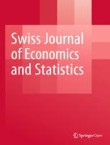The Swiss Journal of Economics and Statistics is published in collaboration with the Swiss Society of Economics and Statistics (SSES) and the Swiss Academy of Humanities and Social Sciences (SAGW). The journal is fully sponsored by the SSES and the SAGW so authors are not required to pay an article processing charge.
Capital Flow Waves to and from Switzerland before and after the Financial Crisis
This paper first shows that capital inflows to and outflows from financial centers were disproportionately affected by the global financial crisis. Switzerland was no exception. The paper then identifies waves...
